ROMANCING THE ‘HUN’ – A LEGENDARY AIRCRAFT FROM WHICH HEROES WERE MADE By Julie Summers Walker, published January 1, 2022. Reprinted in part with permission by Mike Fizer. Additional photos added for interest.
“It is 1968 and I am 10 years old. My beautiful cousin, Cynthia Gay, has brought home yet another handsome young man in uniform, on his way to Vietnam. He is such a romantic figure; I cannot take my eyes off him or keep from holding his hand. Years later the memory of that young man stays with me. There is, as they say, just something about a man in uniform.
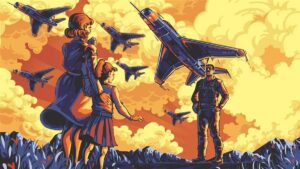
“Dad was a fighter pilot. I remember seeing a photograph of my mom with Dad. I’d never seen her look like that—like she had caught something very special. I teased her about it, and she laughed and said that’s exactly how she felt about marrying Dad.”
Mike Fizer’s father, Bob, grew up in Staten Island, New York. He was a scrappy kid who enlisted in the U.S. Air Force after high school on March 9, 1951, and said that after that day “I never worked a day in my life.” He and his wife, Barbara—whom he met on a blind date—hauled their three kids around the world as he lived his life as a fighter pilot. Bob Fizer flew nearly 4,000 hours in his career, 3,000 of those in the F–100, the Hun, the aircraft that challenged a select generation of young men and made them heroes in a time when heroes were hard to find.
Touched with fire
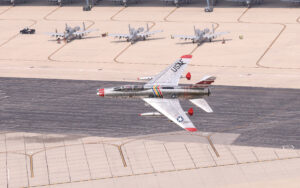
In September 2021, members of the Super Sabre Society gathered in Fort Wayne, Indiana, for the final flight in the only operational F–100, a restored F–100F Super Sabre belonging to pilot Dean “Cutter” Cutshall. The 63-year-old aircraft would take men who risked their lives flying the first supersonic fighter jet for one last flight. The wiry young men in white T-shirts and regulation pants who climbed over that aircraft are now old men with bent backs and sloping shoulders. Their skin hangs heavy off well-worn faces, yet their eyes are bright and their enthusiasm contagious. I once heard a man say his mind thinks he’s 40 while his body knows it’s 92.
From military schools to those who enlisted immediately after high school graduation, the young men who piloted the North American F–100 Super Sabre were—for lack of the word to describe the impossible—brave.
NORTH AMERICAN F-100 SUPER SABRE...
Movie Star
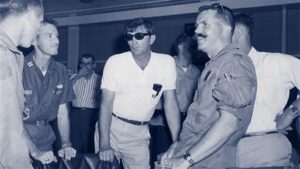
In the 1958 movie The Hunters starring Robert Mitchum (center), Bob Fizer (right) assisted with the aerial scenes. He spent 12 weeks with the film crew in Florida. Operational F–86 and F–84F Sabre fighters were used in the aerial sequences. “Fiz” (pronounced Fize) performed a maneuver credited to John Boyd, a U.S. Air Force fighter pilot. He was dubbed “Forty-Second Boyd” for his standing bet as an instructor pilot that, beginning from a position of disadvantage, he could defeat any opposing pilot in air combat, maneuvering in less than 40 seconds. Fiz would get the shot the film crew had been unable to do in his F–84F. “He gets the shot and they say, ‘Holy cow, do it again’ and he says no,” said his son Mike. “Dad was a hot shot. I grew up watching these guys in green flight suits reacting to my dad.”
According to Defense Media Network, from May 1968 to April 1969 alone, Air National Guard Super Sabres flew more than 38,000 combat hours and more than 24,000 sorties. Over the lifetime of its service, 889 F–100 aircraft were destroyed in accidents, involving the deaths of 324 pilots. The deadliest year for F–100 accidents was 1958; 116 aircraft were destroyed, and 47 pilots were killed.
To revere such a killer seems ironic. But here on the ramp at Fort Wayne, these former pilots are remembering their first flights in the F–100, and their remembrances are with respect, honor, and affection.
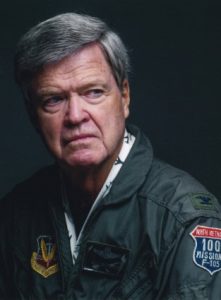
John C. Morrissey, who flew the F–100 in 1962 and who took a flight with Cutshall in September, quoted Oliver Wendell Holmes Jr.: “We have shared the incommunicable experience of war, we have felt, we still feel, the passion of life to its top. In our youth our hearts were touched with fire.”
Morrissey held back tears as he recounted his flight. “I figured I had one more burner light in me before I go to fighter pilot heaven. To smell the jet fuel; to hear the afterburner; to feel the sensations again. It was like a symphony of a way of life—a life like no other. If I got to do it over, I’d consider myself blessed.”
Supersonic
The North American F–100 Super Sabre was the first U.S. Air Force aircraft capable of exceeding the speed of sound in straight-and-level flight. It was a redesign of the F–86 Sabre. The F–100 had a 45-degree sweeping wing in contrast to the F–86’s 35 degrees. The prototype of the F–100 was built by North American Aviation in its Los Angeles plant in 1951 and took its first test flight in May 1953. The second test flight was in October 1953 and the first production aircraft with its afterburning engine—a Pratt & Whitney J57-P engine—went to the U.S. Air Force in 1954.
The single-pilot aircraft had a clamshell canopy and the pilot sat on an ejection seat. There were five fuel tanks, all in the fuselage. The aircraft had a reputation for being hard to manage; if the pilot was slow on approach, the airplane would pitch up—pilots called it the “Sabre Dance”—and it would flip over on itself. Test pilot George Welch was killed in 1954 when the aircraft he was flying spun out of control. He ejected but died of his injuries.
The U.S. Air Force designed the F–100 as an air-superiority fighter; however, it used the aircraft instead as a fighter-bomber. Pilots released bombs at low altitude, then turned away as the weapon dropped toward the target. The pilot then engaged the afterburner and flew away as quickly as possible.
On April 16, 1961, six Super Sabres deployed from Clark Air Base in the Philippines to Don Muang Royal Thai Air Force Base in Thailand, the first F–100s to enter combat in Southeast Asia. In 1965, the United States began expanding the number of F–100 squadrons in the conflict area. Most of those F–100s were painted a green-brown color scheme known as T.O.114 camouflage, the T.O. for a technical order. Developed as an air-to-air fighter with great capability—including a redesign of the tail after the crash that killed Welch—the F–100 was affectionately called the Hun.
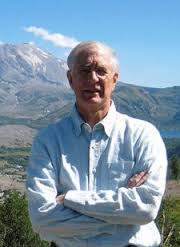
Don Shepperd said he dreamed of being an F–100 pilot after seeing the aircraft as a U.S. Air Force Academy cadet. He flew the Hun in Vietnam and was a member of the Mistys, an elite group of F–100 pilots who flew some of the most dangerous missions during the conflict. Top secret, the missions involved low-level flying to seek out targets in flights lasting four to six hours with in-flight tanker refueling three times.
The Hun was the first U.S. Air Force fighter used for electronic warfare in the “Wild Weasel I” program, which used the F–100F in missions to seek and destroy surface-to-air missile (SAM) sites. One of the most dangerous missions was the Misty operations; the two-seat F–100F flew low along the Ho Chi Minh Trail. “Misty” was the radio callsign used by the F–100F Fast Forward Air Controllers (Fast FACs). There were 157 pilots officially assigned to fly missions over North Vietnam from June 15, 1967, to May 19, 1970, according to Shepperd.
“We were shot at all the time. We lost an airplane every fourth mission, and then we’d try to find them [the pilot]. said Shepperd.
The last F–100 left Vietnam in 1971, after nearly eight years of combat. The F–100s were the longest serving U.S. jet fighter-bomber in the Vietnam War. Shepperd became a writer and CNN correspondent, and co-wrote Bury Us Upside Down, a book about his time in Vietnam. “It was a dumb-ass war; we went in for the right reasons, but war is not that simple,” he said. He writes, he says, to “remember the people we lost, the things we did, the things we were required to do.”
…AKA THE HUN
Farm boys
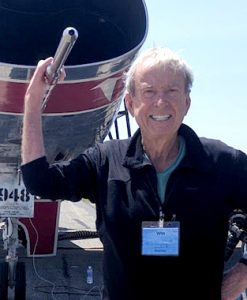 Win Reither flew 292 combat missions in the F–100 in Vietnam. On May 3, 1968, he was flying to Bien Hoa near Saigon behind U.S. Air Force academy graduate Jim Martin who was moving fast in his F–100. Reither tried to keep up. He soon realized Martin’s aircraft was hard hit, having sustained damage from an engagement with a hostile North Vietnamese Army unit with semi-automatic and small arms fire.
Win Reither flew 292 combat missions in the F–100 in Vietnam. On May 3, 1968, he was flying to Bien Hoa near Saigon behind U.S. Air Force academy graduate Jim Martin who was moving fast in his F–100. Reither tried to keep up. He soon realized Martin’s aircraft was hard hit, having sustained damage from an engagement with a hostile North Vietnamese Army unit with semi-automatic and small arms fire.
“Somewhere in the mission Jim got hit pretty bad and started streaming fuel and we headed to the nearest base,” Reither remembered. “Afterward, I learned that Jim was losing fuel fast and, as he understood the complexity of the F–100, he turned off the AC generator so the fuel transfer would slow, and he wouldn’t run out of fuel. His airplane had a lot of holes in it and he was lucky to get on the ground. I finally caught up with him and was happy to see him land successfully. I was the awards and decorations officer for the squadron; I decided to put the flight in for a Distinguished Flying Cross.”
In hindsight more than 50 years later, Reither says he wishes he’d put Martin up for five DFC medals and had better thanked his operations officer. “We wrote mission reports like it was just another day, and we got up and flew another mission the next day.”
Most of the young men who signed up were “farm boys,” Reither said. “They were clever guys, but most were just high school graduates….But everyone wanted to fly that jet, to go supersonic.”
The F–100 was tricky to fly. The pitch angle made it seem like you had a rocket at your back and the tail was too small, Reither said. “They always put a too-small tail on the prototypes,” he said. But the Air Force built 171 of those test models, and 128 crashed. “The boys just came off the farm and flew supersonic. It was like being the quarterback on the football team. They couldn’t write a good sentence, but if they took you, they’d train you.”
Last flight
The Super Sabre Society was formed in 2006 to preserve the memory of the men who flew the Hun in Vietnam. Cutshall, purchased 63948, the F–100F, in 1996 with the help of his Crew Chief Paul Swick and Engine Technician Jim “Prez” Prezbindowski, both who have many years of experience with the Hun. Cutshall initially paid $250,000 for the F–100, then “after two years and $700,000, old 948 looked and performed as if it was just rolled out of the factory,” Cutshall said. Swick and Prezbindowski, along with their friends from the 122nd Fighter Wing, worked many hours restoring the aircraft. For the past 25 years, Cutshall and crew have shown off the airplane at airshows around the country and offered rides to former pilots and crew of the Hun (see “One More Time,” November 2016 AOPA Pilot).
Reither says Cutshall has said each year this would be the last flight. “I guess we’ll see,” he said.
The fighter pilot
The younger Fizer’s conversations are always peppered with stories about his father, the Hun, and the family’s various postings across the world. “These guys knew what they were doing was dangerous, but they still wanted to go. They were committed, they were warriors with integrity and courage. It’s an ancient story—as long as there is war and there are soldiers.”
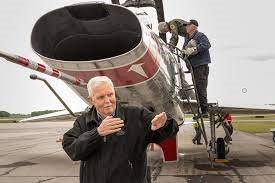
He uses words like “bravery” and “courage” when he talks of the fighter pilots, who he has met over the years, first as a child and then later attending Super Sabre events like the one in September. This time, however, without his father. Bob Fizer and his friends and fellow pilots are aging, their bravery and feats flying some of the most difficult aircraft in the most challenging circumstances retreating to memories and the history books.
“First of all, let me make this clear: We were not heroes but rather we were just ordinary men in extraordinary circumstances,” said retired U.S. Air Force Gen. Chuck Boyd, an F–105 fighter pilot and seven-year POW who became a four-star general. “The fighter pilots I have known are, by and large, a fiercely individualistic breed of men. There is not a fighter pilot worth his salt who would not prefer to fly alone in a single-seat aircraft, relying totally on his singular skills than to work as a part of a committee on any multi-seated air machine.
“And so, it should not seem surprising that this breed of men would be as well-equipped as anyone to cope with isolation. The enemy captors thought they could divide and conquer; that without collective leadership we would not be able to maintain our resistance and resolve. But they did not reckon with the individual integrity of the American fighter pilot. In this world of changing values where the individual dignity of man seems to be eroding in the society, I think you would do well to remember the example set by men who refused to compromise their individuality.”
For the full article go to https://www.aopa.org/news-and-media/all-news/2022/january/pilot/romancing-the-hun
